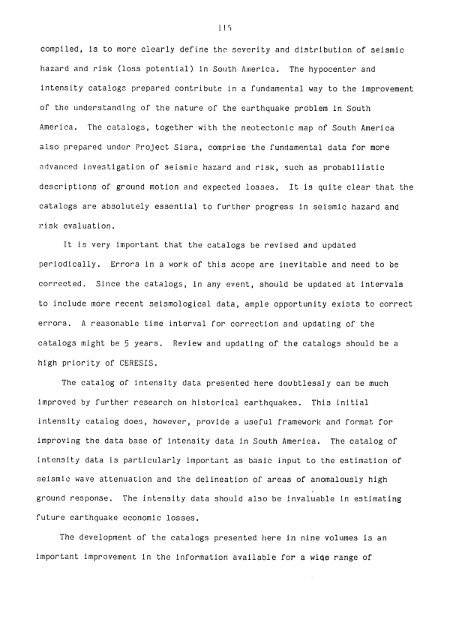catalogo de terremotos para america del sur catalog of earthquakes ...
catalogo de terremotos para america del sur catalog of earthquakes ...
catalogo de terremotos para america del sur catalog of earthquakes ...
You also want an ePaper? Increase the reach of your titles
YUMPU automatically turns print PDFs into web optimized ePapers that Google loves.
115<br />
compiled, is to more clearly <strong>de</strong>fine the severity and distribution <strong>of</strong> seismic<br />
hazard and risk (loss potential) in South America. The hypocenter and<br />
intensity <strong>catalog</strong>s prepared contribute in a fundamental way to the improvement<br />
<strong>of</strong> the un<strong>de</strong>rstanding <strong>of</strong> the nature <strong>of</strong> the earthquake problem in South<br />
America. The <strong>catalog</strong>s, together with the neotectonic map <strong>of</strong> South America<br />
also prepared un<strong>de</strong>r Project Sisra, comprise the fundamental data for more<br />
advanced investigation <strong>of</strong> seismic hazard and risk, such as probabilistic<br />
<strong>de</strong>scriptions <strong>of</strong> ground motion and expected losses. It is quite clear that the<br />
<strong>catalog</strong>s are absolutely essential to further progress in seismic hazard and<br />
risk evaluation.<br />
It is very important that the <strong>catalog</strong>s be revised and updated<br />
periodically. Errors in a work <strong>of</strong> this scope are inevitable and need to be<br />
corrected. Since the <strong>catalog</strong>s, in any event, should be updated at intervals<br />
to inclu<strong>de</strong> more recent seismological data, ample opportunity exists to correct<br />
errors. A reasonable time interval for correction and updating <strong>of</strong> the<br />
<strong>catalog</strong>s might be 5 years. Review and updating <strong>of</strong> the <strong>catalog</strong>s should be a<br />
high priority <strong>of</strong> CERESIS.<br />
The <strong>catalog</strong> <strong>of</strong> intensity data presented here doubtlessly can be much<br />
improved by further research on historical <strong>earthquakes</strong>. This initial<br />
intensity <strong>catalog</strong> does, however, provi<strong>de</strong> a useful framework and format for<br />
improving the data base <strong>of</strong> intensity data in South America. The <strong>catalog</strong> <strong>of</strong><br />
intensity data is particularly important as basic input to the estimation <strong>of</strong><br />
seismic wave attenuation and the <strong>de</strong>lineation <strong>of</strong> areas <strong>of</strong> anomalously high<br />
ground response. The intensity data should also be invaluable in estimating<br />
future earthquake economic losses.<br />
The <strong>de</strong>velopment <strong>of</strong> the <strong>catalog</strong>s presented here in nine volumes is an<br />
important improvement in the information available for a wi<strong>de</strong> range <strong>of</strong>

















